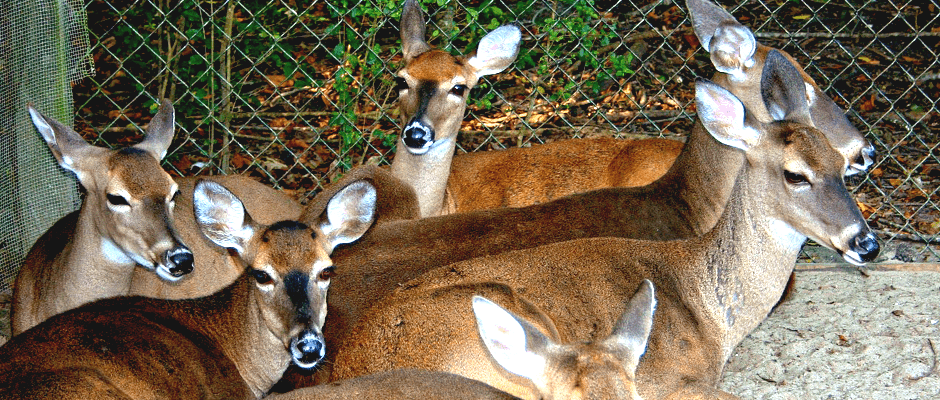Share this article
The Conservation Affairs Network — from The Wildlife Professional
Strengthening TWS and Our Role in Policy
Over the past two decades, expansion of captive cervid propagation and commercialization activities in the United States has threatened the health of wild populations of deer. In 2015, several states mounted efforts to transfer authority of captive cervids away from state wildlife agencies as well as to expand the industry — moves that have the potential to further spread chronic wasting disease. When The Wildlife Society’s North Carolina Chapter became aware of its state legislature’s desire to make such changes, chapter leaders contacted TWS Government Affairs staff. Staff and chapter leaders worked together to draft a letter to North Carolina lawmakers opposing S.513 on the grounds that private ownership of deer conflicts with one of the key tenets of the North American Model of Wildlife Conservation and that the captive cervid industry poses a threat to wildlife health. Although the state’s legislators recently passed the bill, the voice of wildlife professionals was heard and was a part of the process.
This is just one example of TWS’ efforts to increase communication and encourage collaboration among our chapters, sections, working groups and TWS staff though our Conservation Affairs Network (CAN). Terra Rentz, former TWS Deputy Director of Government Affairs and Partnerships along with several TWS members recognized that more could be done to advance wildlife and conservation efforts nationwide. They set out to eliminate independent actions and duplication of efforts. Formally launched in 2014, CAN also implements elements of the Society’s 2015-2019 Strategic Plan to step up networking activities and better support all TWS units.
Focus on Policy
Initially, CAN focused on integrating efforts related to wildlife policy. This concentration made sense because most units already had established procedures for addressing policy issues that created a foundation for TWS to build and expand upon. In addition, wildlife policy is established by all levels of government. The structure of TWS chapters, sections and headquarters allows the Society to strengthen its voice at local, regional and national levels.
CAN does not intend to generate more policy activities within TWS units, but rather to connect them on similar issues that arise in states and provinces. By sharing information and knowledge through CAN, units can collaborate more closely and improve their efficiency and effectiveness.
Policy ultimately has a large impact on wildlife management, conservation and the wildlife profession.
Consolidating the Society’s actions and involvement in wildlife policy will enable TWS to better support members as they face policy-related challenges and opportunities.
How CAN Works
CAN creates direct linkages among TWS chapters, sections and headquarters through Conservation Affairs Committees (CAC) or similar committees in each unit that monitor policy issues and take actions on behalf of their members. Chapter CACs are integrated in the larger geographic region through a Section CAC consisting of Chapter CAC Chairs. These individuals communicate regularly with each other and the TWS Government Affairs staff.
Communication via conference calls, emails and newsletters allows information to be shared throughout the network. All CACs are made aware of activities and issues being addressed by others in the network, which enables sections and chapters to coordinate their efforts on wildlife policy issues. TWS Working Group leaders are also plugged into the conversations to provide additional technical expertise related to policy issues.
Delivering Benefits to Members
Although CAN has only been fully active for one year, it has already begun to benefit TWS units and members.
TWS’ Virginia Chapter took action in February 2015 to oppose several pieces of state legislation that encouraged trap-neuter-release programs for feral cats. The chapter’s success has encouraged other TWS units to initiate efforts aimed at educating the public on the impacts of feral cats and such programs.
| Learn More About CAN
TWS’ role in policy is critical to the future of our profession — and the Conservation Affairs Network is helping the Society fulfill that role. You can learn more about it at wildlife.org/conservation-affairs-network and get engaged by contacting your TWS chapter, section or working group. |
TWS members in Wisconsin received support from the North Central Section earlier this year when Governor Walker introduced a budget proposal that cut several research staff positions from the state’s department of natural resources. The tense political climate in the state discouraged the Wisconsin Chapter from taking action, so the Section stepped in to assist and sent a letter to the governor expressing their concerns about the budget cuts and the need to support wildlife research and enable wildlife professionals to do their work.
CAN also has taken actions on national wildlife issues. The State & Tribal Wildlife Grants program is a federal program that provides funding to states and tribes for the conservation of non-game species. These funds enable wildlife professionals to monitor, research and manage a diversity of wildlife that has historically been underfunded. TWS Government Affairs staff notified sections, chapters and members about efforts to support this program in early 2015. Several sections and chapters sent letters to their Congressional delegations in an effort to build support for the program.
One Voice for Wildlife Professionals
TWS has a longstanding role in informing policymakers of the impacts their decisions have on wildlife and in advocating to ensure that policies are based on sound science. As the sole organization representing wildlife professionals employed by federal and state agencies, tribes, non-profit organizations, and private firms, the Society is the voice for wildlife conservation and management in the policy arena. Through CAN, not only is TWS more efficient and effective in its national effort, but our members are also better prepared to advocate for wildlife policies that impact them locally.
Our Mission: Inspire, Empower and Enable
The Wildlife Society’s mission is to inspire, empower and enable wildlife professionals to sustain wildlife populations and habitats through science-based management and conservation. Engaging in policy issues is essential for TWS to achieve that mission. Policy can fundamentally alter wildlife professionals’ power and ability to perform science-based management.
Some issues in wildlife management can only be solved by changes in policy such as restricting the introduction and spread of invasive species, preventing disease transmission between domestic and wild animals or designating areas of protected habitat.
TWS Government Affairs staff and the Conservation Affairs Network work to ensure that wildlife policies:
- Empower wildlife professionals by incorporating wildlife science, continuing the public trust management of wildlife and granting them the ability to regulate the use of wildlife resources.
- Enable wildlife professionals by supporting sufficient funding for wildlife conservation and providing them with the resources and ability to conduct their work.
- Assist wildlife professionals by helping them achieve science-based management and conservation.
TWS reviews its policy priorities annually on the most pressing topics in wildlife management and conservation, which include: climate change and adaptation; endangered species recovery; energy development and wildlife; federal employee participation in professional societies; funding for wildlife conservation and management; invasive species prevention and management; strategic conservation planning; wetlands conservation; and wildlife health. You can find more information on our website, wildlife.org/policy.
Header Image: A group of white-tailed deer rests behind a fence in a deer farming facility. The Conservation Affairs Network is delivering more effective and efficient actions on behalf of TWS members such as opposing the expansion of the captive cervid industry that threatens the health of wild cervid populations. Image Credit: James DeMers








